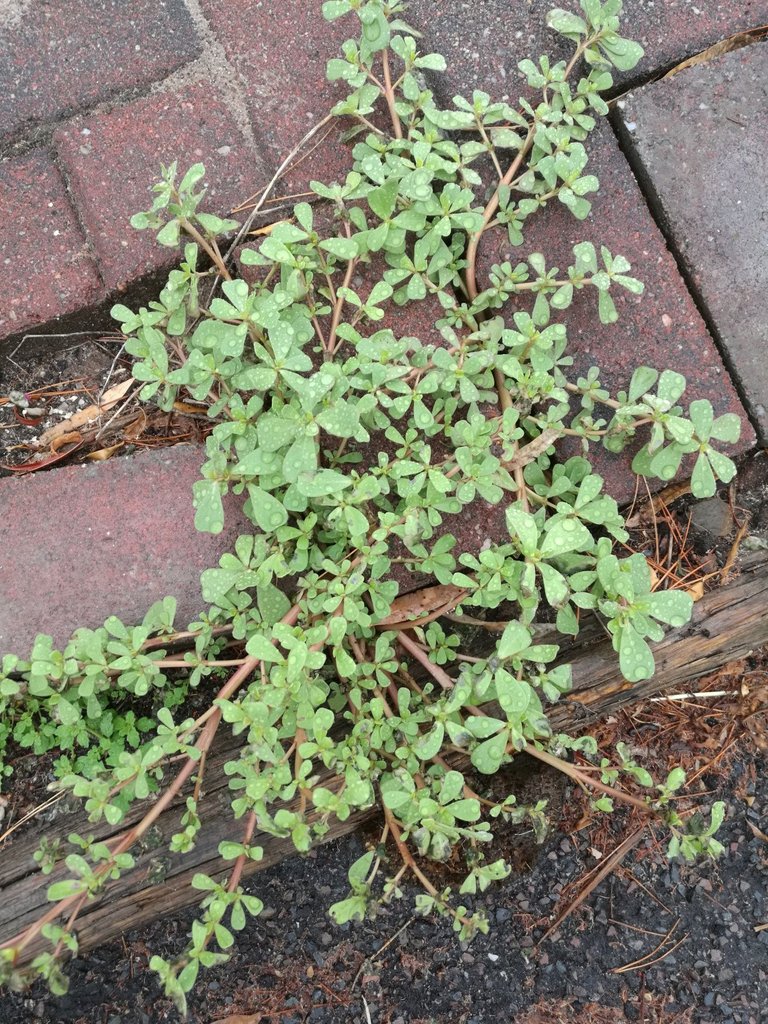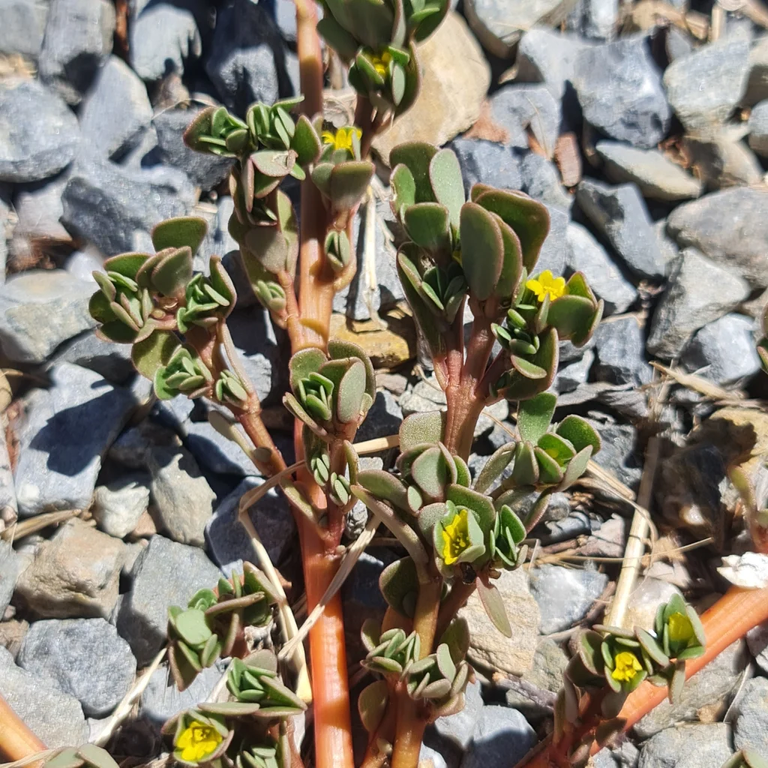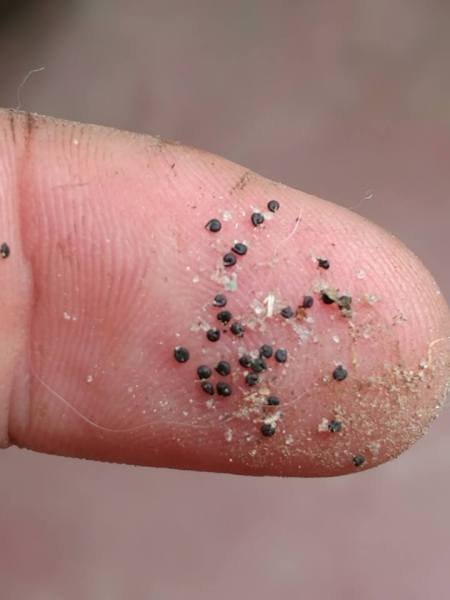Purslane (Portulaca oleracea)

Common names: Purslane, Common Purslane, Pigweed, Ma Chi Xian, Kulfa
Taxonomic name: Portulaca oleracea
Family: Portulacaceae
Area of origin: seems like everywhere but the Americas
Parts used: leaf, seed, stem
Can be used for: food, vitamin C deficiency, Indigenous bread making
Actions: nutritive, astringents, hemostatic, febrifuge, antipyretic, antihelminthic, scourbitic
Taste: sour, just a touch salty
Tissue states: heat, damp heat
Energetics: cooling, clears heat, moistening
Healing constituents: mucilaginous substances, omega-3 fatty acid, alpha-linolenic acid (ALA), gamma-linolenic acid, alpha-tocopherol and ascorbic acid, potassium, magnesium, calcium, oxalates
Warnings: none
Description
As Summer gets underway, Purslane (Portulaca oleracea) or ‘Pigweed’ as it is also known, is growing just about everywhere, with no help from us at all. Its spreading habit and thick leaves and succulent, red/brown stems make Purslane easy to identify as it pops out from foot paths, sidewalks and gardens. It also has tiny, yellow flowers that brighten things up a little.
Purslane seems to thrive on neglect. The best leaves and thickest stems often grow where the soil is worst and the Sun is unrelenting. In these places, the leaves fold up in mid afternoon or when the heat gets excessive but they’re back down at the first sign of moisture or coolness.
As with many plants out by footpaths and verges at this time of year, Purslane’s low, spreading habit helps protect the soil beneath it and its deep taproot helps bring up moisture and nutrients to the surface. Once dead at the end of the season, the root rots and provides access into the soil for water and air and food for microbes and Fungi who kick off the soil cycle.
A single plant can produce many thousands of tiny black seeds which are as nutritious as the rest of the plant. That’s another characteristic of ‘Nature’s Bandaids’ as I call the humble, protective plants that are around in this season. Others that you may see are Caltrop (Tribulus terrestris), Wireweed (Polygonum aviculare) and Plantain (Plantago lanceolata).

Medicinal use
One of the interesting things about Purslane is that its nutritional level varies throughout the day as it changes its style of creating and storing energy. I won’t bog you down with a lecture on phytochemistry though.
Purslane has been used as a salad vegetable around the world and does well as a green veggie in other dishes. It also makes for an interesting ferment – that’s a good way to use up the thicker stalks. Just cover them in lightly salted water for three to five days until bubbles start to form, then leave until it suits your taste.
Beside eating it as a vegetable, local Aboriginal folk use it as a binding agent when making cakes of Acacia seed flour. Its mucilaginous nature makes it an excellent binding agent at a time when water is scarce.
Purslane is a highly nutritious plant with high levels of Omega- 3 fatty acid, ALA (alpha linoleic acid), potassium, calcium, magnesium, Vitamins A, B, C, E and carotene. It has a ‘depurative’ effect, which means it is used as a purifier in the body and is used as an ‘antiscorbutic’ (don’t you love these words!), meaning that it is used for ailments resulting in vitamin C deficiency.
Fatty acids are used to transport hormones and other substances to where they’re needed around the body, making them absolutely essential for proper functioning of cells and organs.
Eat a little fresh Purslane and keep the chewed leaves in your mouth for a while and you will begin to feel the soothing, moistening nature of Purslane as it it becomes slimy after a little while as the mucilages are released by the chewing and saliva.
Herbally, Purslane’s moist, slightly sour and salty taste tells us that it is great for using in cases of heat. Plants with sour tastes tend to cool and disperse heat, that’s why we love sour tastes in Summer – fruit juices and berries top everyone’s list of favourite foods.
Juice from the stems is used externally to speed the healing of minor wounds and it is great for relieving localised itching. The Plant’s cooling nature can be of great benefit in cases of eczema, psoriasis and prickly heat (I wish I’d known of this as a kid, I used to suffer terribly from that affliction).


I cheat a bit when I grow Purslane. Even though one plant can supposedly produce around 250, 000 seeds (you can eat them too!), it’s much easier to find a wild one, dig it up and transplant it into your garden. A little water for a day or so and away you go!
Purslane has some other great uses for the homesteader or permaculturalist beside food for ourselves. It is much loved by pigs (hence one of its nicknames) and chickens. They go crazy for it and it does good things for them, giving the yolks a brighter yellow colour.
Nutritious, tasty and free, demanding no attention and giving so much – what more can we ask? Thank you, Purslane!
Preparing and using
Eat the fresh herb in salads or added last to cooked meals. It doesn’t fare well with too much cooking. If your mouth is dry, chew a couple of Purslane leaves slowly to get the soothing mucilage out of them, Dry the seeds and use them later like Amaranth or Chia.
Purslane dries fairly well, though its succulent nature means that it dries slowly. To use it dried, a slow decoction of leaves and stems works best.
I'm doing a huge update on our herb pages on Ligaya Garden Online and sharing them here for the @naturalmedicine community. I want to share what I know of this topic so that, as the world gets crazier, folks will have other avenues of medical care, namely those of themselves and their community. If you look back over this blog, you can see heaps of info on the topic, plus loads and loads of posts on herbs and using Australian bushfoods from a white perspective. If you haven't been around on in the @hivegarden and @naturalmedicine communities for long, you may be interested in looking back. There's w-a-a-a-a-y too much there for me to repost and the Hive system doesn't let you vote on old posts so, if you're happy with what you find, I believe that there is now a tip option...






Oh I love this herb in my garden! I tried to save the seeds, but they grow best when they self-seed in my opinion. I love to add this to salads or tzatziki! I read somewhere when you use it in conjunction with something sour, think lemon juice, or yoghurt, you considerably reduce the potential negative effects of oxalic acid. Thank you for sharing wonderful information about a spectacular herb!
No worries! Glad to find someone else who appreciates this humble little groundcover.I'll follow up about the lemon juice to remove oxalic acid...haven't heard of that one.
I love it. Apparently, they used it in my local cooking culture for many years to thicken stews. Now, people see it as one of the worst weeds they want to get rid of. Such a shame that so much knowledge is lost. Only one generation ago, they still cooked with many of the wild plants, now people poison their gardens to get rid of essentially free food.
It's true.
Ow interrsting plant , good one to know if you are in the woods with some eczema hehe
`
Want to Know more about Hivepakistan?
Ping Us On Hive Pakistan Discord server
To support HivePakistan, delegate Hive Power to hivepakistan and earn 90% curation reward :)
Here are some handy links for delegation
A delegation of 500 or more HP makes you earn Hivepakistan supporter badge.
`
You could live on it, cure your rash and its soft enough to make a pillow of it!
I'm always pretty excited when my posts are shared in other countries besides Oz. I get great feedback and more knowledge on how to use the plants discussed. Sharing is what it's all about.
Just delegated 500 HP to @hivepakistan
Saludos, que excelente publicación de esta maravillosa planta, la conozco, siempre aparece en el patio de la casa. Gracias por compartir la información de sus ventajas. 👏
Gracias. Es una planta que ama los patios y las grietas en las superficies pavimentadas; debe pensar que necesitan reparación.
Por favor, comparta la publicación con la comunidad de habla hispana. Estoy tratando de difundir la información lo más posible y estaré agradecido por su ayuda.
Thanks for sharing this
No worries. There's one like this to come as I update our pages. Please share them around.
great plant ! :) great post
Thank you, from me and the plant.